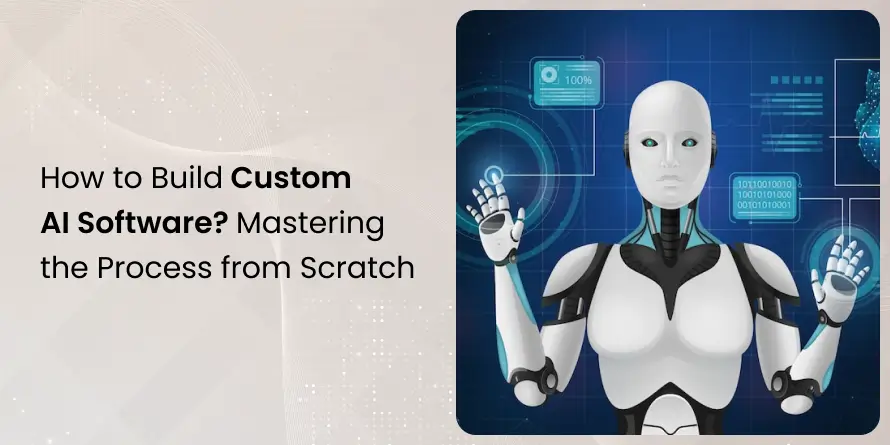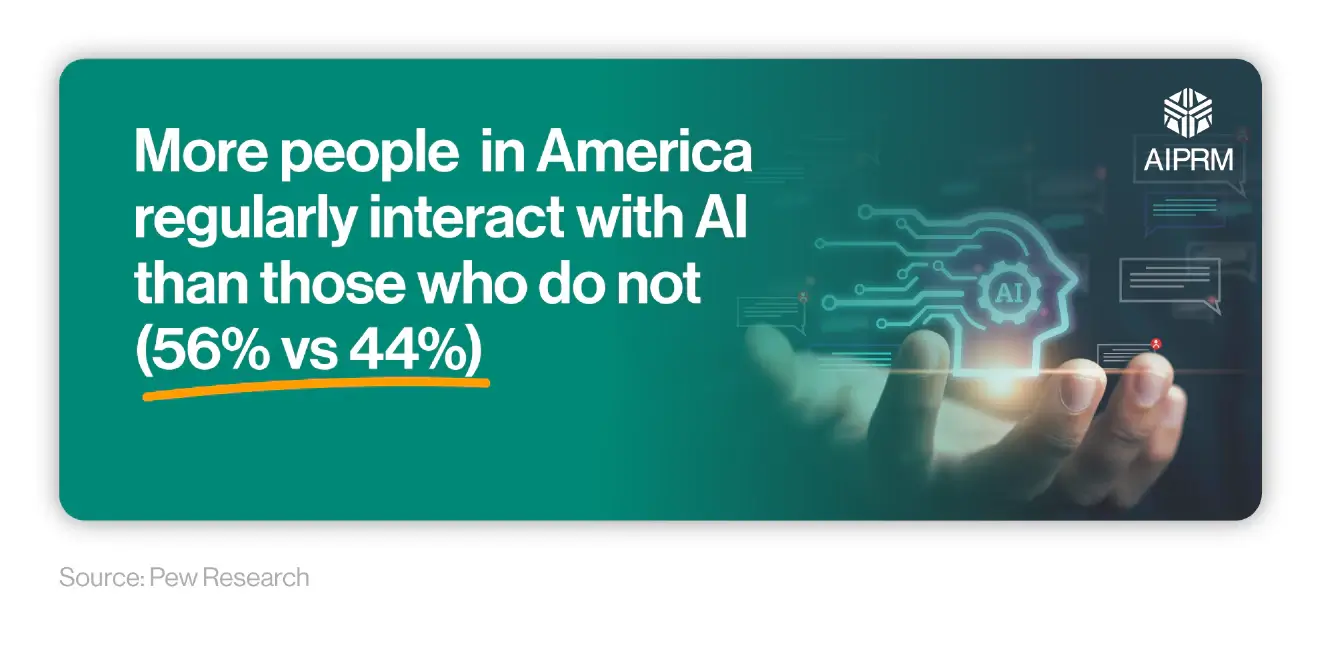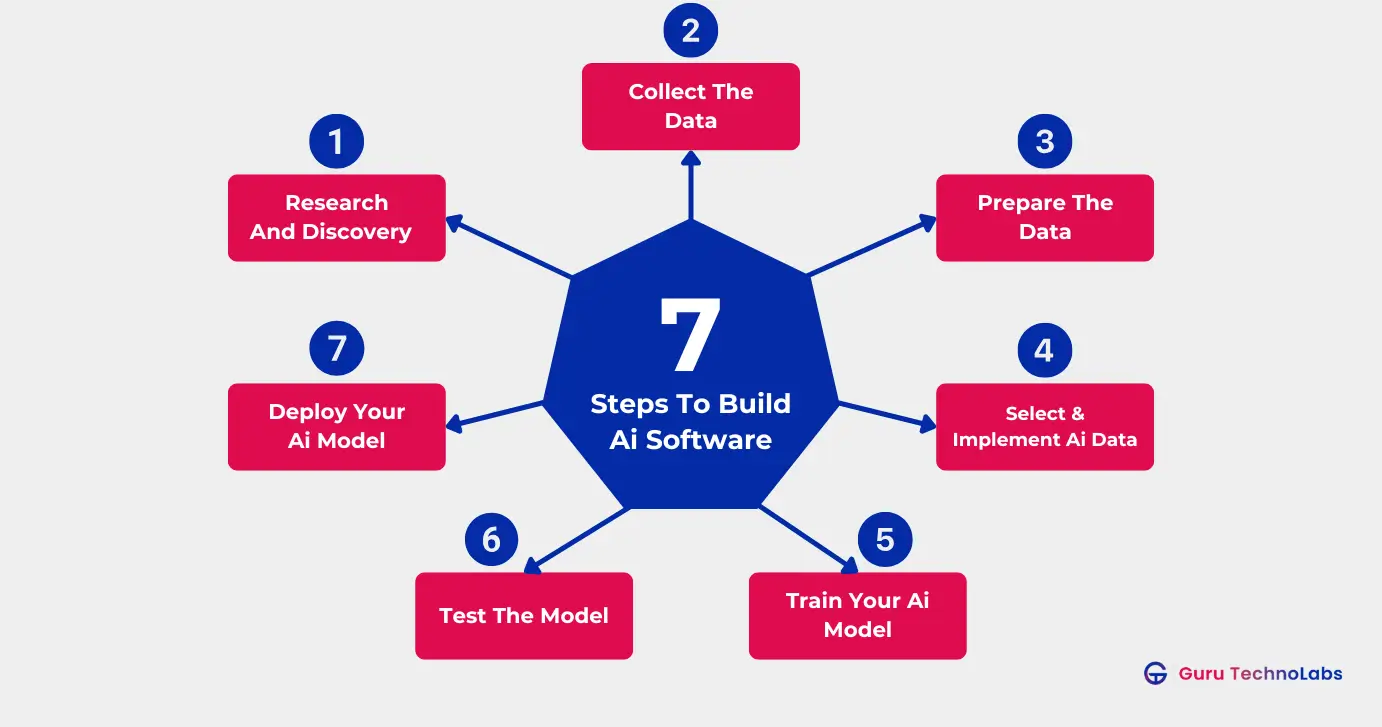How to Build Custom AI Software? Mastering the Process from Scratch

In the digital era, Artificial Intelligence (AI) has become mainstream in professional and personal lives. From voice assistants like Siri and Google Assistant to ride-sharing apps such as Uber and Lyft, AI empowers the systems that streamline, enhance, and improve our regular tasks. Whether getting personalised recommendations from Netflix or assistance from chatbots for customer support, AI is embedded everywhere and, more often, in ways we don’t even pay attention to.
The demand for custom AI software solutions is increasing as AI continues penetrating daily operations. Startups and enterprises across all industries want to leverage AI-powered solutions to overcome specific challenges and boost efficiency.
Moreover, as per the study conducted by McKinsey, it is believed that the AI market is projected to reach $190 billion by 2025, with more and more brands inclined to make investments to stay competitive in an AI-driven world. As a business owner or entrepreneur, you want to leverage AI to accelerate your business growth.
Hence, you might wonder how to build custom AI software or solutions, the steps to perform, and other associated information. This blog gives you a complete idea of creating your own AI software for your business. So, let’s get started without any ado.
What is Custom AI Software Development?
Custom AI software development is the process of designing and developing AI-powered solutions that are specifically tailored to the needs of a business or an application.
The development process typically takes an understanding of business challenges, designing AI algorithms, collecting relevant data, and training models so that the solution effectively and scalably solves the business problem. Custom AI solutions may be as simple as machine learning models that predict customer behavior, NLP systems to automate customer service, or, more exotically, computer vision algorithms for facial recognition or product quality control.
To develop an effective custom AI solution, it is prudent to work with an AI development company that not only understands the technical side of things but also offers scalable solutions, including white label software development, to meet diverse business needs. Company understands the specifics of AI algorithms such as deep learning, decision trees, and reinforcement learning, which are the basis of so many intelligent systems today.
For example, Tesla uses deep learning and neural networks to build up its self-driving car systems, further improving algorithms to ensure excellent safety and efficiency. This is one of the best examples of how businesses successfully apply custom AI development to gain an edge over their competitors.
What are the Different Types of Custom AI Solutions?
From automation to personalised recommendations, custom AI solutions are developed to meet specific needs and challenges across industries. Below, we’ll explore some of the most common custom AI solutions types and how they’re transforming industries.
AI Agents
AI agents are intelligent systems designed to perform tasks autonomously, provide decisions, and interact with users or other systems. These agents are mainly applied for automating repetitive processes, such as data entry or customer service inquiries. They make this tool very important to the business community looking to become more efficient.
Also read: Top Al Agent Examples
Chatbot and Conversational AI Solutions
Among the most popular and impactful custom AI solutions today are AI-based chatbots. The chatbot app development enables businesses to build an increasingly experienced bot in understanding and responding to specific customer needs while providing 24/7 support, thereby enhancing customer satisfaction levels. Additionally, many businesses are opting for SaaS app development to deploy AI-driven chatbot solutions that offer scalability, seamless cloud integration, and cost efficiency.
Machine Learning Models
Machine learning models lie at the heart of many customised solutions with AI. The models learn from data and improve the way they predict without explicit programming. The applications include using ML models for predictive analysis, fraud detection, and recommendation systems, among others.
Computer Vision Solutions
Computer vision is a domain of AI wherein a machine takes visual information from a picture or video and develops an understanding of it.
Natural Language Processing (NLP)
NLP is the AI field that enables computers to understand, interpret, and generate human language, thereby making it possible for businesses to create systems that can automatically process customer feedback, sort and categorise emails, or generate personalised content based on user preferences.
Why is AI Systems Worth Investing In?
Artificial intelligence is not a buzzword-it is a transformational technology with a high potential to modify markets, improve the efficiency of operations, and spur business growth.

Source: AIPRM
A report published by PwC stated that AI could add up to $15.7 trillion to the global economy by 2030, with 45% of that growth coming from productivity increases enabled by AI.
- AI systems can also make way for the automation of mundane, resource-consuming processes so labour can be directed towards strategized activities.
- At the same time, AI-driven solutions can help companies save on operational costs with process automation and workflow optimization.
- AI systems analyse massive volumes of data, thus identifying insights that may remain invisible to the human eye.
- From personalised recommendations to efficient customer support through chatbots and AI agents, AI enhances the customer journey by delivering customized solutions.
- Investing in AI helps businesses stay ahead of their competition. As AI adoption gathers steam, companies that are among the earlier adopters of AI systems will innovate faster, improve product offerings, and serve customers better than those who don’t.
Whether striving to streamline efficiency with automation, make better decisions with data insights, or give each customer a personalised experience, custom software development for AI can provide bespoke solutions, making these benefits possible.
Transform Your Business with Custom AI Development Solutions
Use AI to discover new insights and make better decisions.
Our customized solutions aim to enhance your business intelligence.
How to Build AI Software in 7 Easily Steps?

Building AI software is challenging yet rewarding. Whether you are creating an intelligent system for a business, product, or innovative service, building in a structured manner ensures that crucial steps are not missed.
1. Research and Discovery
What you should do before diving into writing code is define the problem that you’re solving and the context of your AI solution. Researching your situation allows you to identify the best approach, technologies, and tools for your project.
- Define the Problem: Clearly communicate the problem you are solving with AI software. Is it a predictive model for sales forecasting or an image recognition system in manufacturing? Understanding the scope of your situation will help you make informed decisions.
- Feasibility Study: Analyze the feasibility of using AI to solve the problem. For instance, explore how AI can help brands opt for digital transformation or how it may streamline product development processes.
- Technology Landscape: Explore the appropriate technologies, frameworks, and libraries to use for your AI solution. Understanding the right AI technology stack is crucial here, as it helps you choose the best combination of tools, frameworks, and infrastructure depending on whether you’re working with neural networks, machine learning (ML), or natural language processing (NLP).
2. Gather the Data
Any AI system is based on data. The better and more data you can collect, the better the model you can develop.
- Data Sources: Identify where data will be sourced from, from post records, real-time feed of data, or user-generated content. For example, if you are developing an AI-powered sports system, you shall require performance data, player analytics, and game related data.
- Data Quantity: Have enough data so that the model can train the algorithm. Massive amounts of data are necessary for the successful training of effective creation of AI models.
- Data Variety: It should contain diverse data, that is, all varied possible scenarios for which the AI model is expected to encounter in real-world applications.
3. Prepare the Data for Model Training
Once you have collected the data, the next important step is preparing it for training the AI model. The quality of your data preparation plays a significant role in the performance of your AI system.
- Data Cleaning: Raw data often contains errors, inconsistencies, or missing values. Use techniques like data imputation or filtering to clean the data.
- Data Transformation: This process transforms data to fit the model. For instance, in image-based applications of AI, images are converted to numerical value vectors.
- Data Augmentation: In cases where one does not have enough data, augmentation techniques can be supported by generating new artificial data from existing datasets. For example, adding flip, rotate, and scale images creates variations for images.
4. Select and Implement AI Model
The proper selection of an AI model is necessary to solve your problem efficiently and accurately. This stage involves testing several models to find the one best for the work.
- Choosing the Right Algorithm:Depending on your use case, you might select a supervised learning model (like linear regression or decision trees) or an unsupervised model (like k-means clustering).
- Model Customization: Customize the model to fit your data. This could involve adjusting hyperparameters or choosing the appropriate loss function and activation functions.
- Implementation: Implement the chosen model in one of the popular AI frameworks like TensorFlow, Keras, or PyTorch. These libraries offer pre-built functionalities for efficient model implementation.
5. Train Your AI Model
Feed the data to the model so that it can learn the patterns. This is fundamentally machine learning.
- Training Process: Divide your set of data into training and testing sets. The training set helps the model to learn, and the testing set helps evaluate the performance of the model.
- Monitoring: Monitor metrics like accuracy, precision, and recall as the model trains to be sure it’s learning correctly.
- Optimization: Learning or choosing hyperparameters, like learning rates and batch sizes, to get the best model performance. Backpropagation and gradient descent are commonly used for minimizing error functions during training.
6. Testing the Model
Once your AI model has been trained, it is time to test; the goal of this process is to evaluate how the model generalizes to unseen data.
- Evaluation Metrics: Use the appropriate evaluation metrics in order to measure how well your model performs; these include accuracy, F1 score, and AUC for classification problems.
- Cross-validation: Implement cross-validation techniques that verify how reliable your model is across different subsets of data.
- Model Tuning: If your performance is not satisfying, consider refining the model by tweaking parameters, gathering more data, or selecting another model.
7. Deploy Your AI Model
The final step, after testing is done, involves deploying the model into a production environment to assist end users.
- Integration: Integrate the model with the existing software infrastructure or systems, including CRMs, eCommerce platforms, or smart devices. Explore how to integrate AI into an app.
- Scalability: Ensure that the model can bear the kind of production-level traffic and scale as needed. Techniques like containerization (using Docker) or serverless computing (like AWS Lambda) can help in scaling.
- Monitoring and Maintenance: Continued monitoring is needed to track performance in real time and address issues as they arise. Regular updates and model retraining may be necessary to keep the model effective and performing.
By following the seven steps mentioned earlier, you can build AI-powered software that not only meets your business’s needs but also offers you scalability and adaptability in the saturated market.
AI Challenges in Software Development
The use of artificial intelligence (AI) in software development has transformed the industry, providing extensive opportunities for automation, efficiency, and more innovative applications. However, despite the promise of AI-driven solutions, several challenges confront developers in the integration of AI with software development processes.
Data Quality and Availability
Quality data of any relevance to AI algorithms is not easy to come by. It is significant to note that, in most cases, accessing clean, well-structured, and large datasets is a challenge.
Bias and Fairness
Biases in the training data can be handled in AI models. Consequently, this can generate unfair decisions or discriminated results, and hence, developers need to make sure that AI models are being trained on diverse, representative datasets.
Scalability Issues
Many AI models involve a lot of computational power. This can be an issue if one needs to scale solutions for much larger applications.
Integration with Existing Systems
The integration of AI capabilities into legacy systems can be complex and resource-intensive, requiring developers to handle compatibility issues while ensuring that new AI components function correctly with existing technologies.
Transparency
AI systems and deep learning models are viewed as “black boxes.” This lack of transparency poses a big challenge for developers to follow the logical sequences through which a model may reach certain conclusions or decisions; this is particularly challenging in regulated industries.
Despite these significant AI challenges to software development, many companies push forward with new investments in technologies, tools, and methodologies that can help face such issues. Innovations like AI-specific frameworks, improving model transparency, and better data-handling practices are setting the stage for the broader adoption of more robust AI solutions in software development.
Build Your AI Software Solution with Expert Guidance
Ready to turn your AI ideas into reality? Schedule a free consultation with our experts to
explore tailored solutions for your business needs.
The Future of AI Software Development
The future of AI software development holds immense potential, and the advancements we’re seeing today are just the tip of the iceberg. As AI develops further, it will be ready to revolutionize everything – from healthcare to finance, making processes more efficient, intelligent, and automated.
The adoption of AI is also spurred by breakthroughs in the areas of machine learning, deep learning, and natural language processing that are improving the abilities of software development and creating more innovative applications.
We can use more automatic coding tools, innovative debugging systems, and personalized user experiences as AI becomes more potent in software development. For example, AI-powered tools such as GitHub Copilot are helping developers write code much more efficiently, thereby improving productivity by as much as 40%. Of course, the rise of AI in cloud computing and edge devices opens new frontiers but makes it possible for users to have access to AI-driven applications in real time on smaller devices.
The future of AI in software development is not just bright; it revolutionizes, opening up sectors to new forms of innovation.
Also Read: Trends in Software Development
So, How Much Does AI Software Development Cost?
The cost of developing an AI app or software may differ from project to project, depending on many factors, including the project’s complexity, the technology stack you choose, and the expertise you need to develop the project.
Other key factors, such as development time, location of the development team, and requirement of special AI knowledge, also play an essential role in costing. If you want to hire developers, a full-time team, or freelancers, both the cost and timeline will be affected. Understanding these factors helps better estimate the overall cost of your AI development project.
Get the Best AI Solutions with Guru TechnoLabs
Building custom AI software from scratch is an exciting process, but it needs proper planning, skill, and patience. Setting up an appropriate roadmap for AI software development makes the entire process frictionless. Embrace the trend, experiment with different frameworks and technologies, and, most importantly, enjoy the process as you unlock the potential of artificial intelligence.
If you are seeking a reliable and trusted partner in AI software development, contact us, as our expertise and commitment to excellence can help you convert your dream into a robust and scalable AI product. So what are you waiting for? Share your requirements and get your custom AI software development started in no time.
Frequently Asked Questions
AI software development involves creating and executing applications that use AI techniques, algorithms, and machine learning models to perform particular tasks.
Python is the most common programming language used to build AI-powered software. Other applications, such as Java, C++, R, and artificial neural networks, are also used.
AI can improve efficiency, boost productivity, and automate specific tasks across multiple domains, from healthcare to finance to media to technology and retail. It can also help businesses to make informed decisions and offer more tailored customer experience.
The numbers mentioned in the article demonstrate how bright the future of AI-enabled software development appears to be. Given the strong demand in business and society, AI technologies seem likely to become the center of the entire software development sector.















